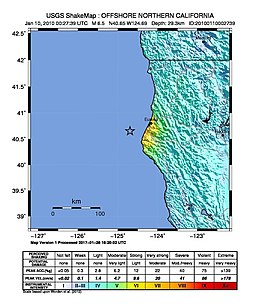2010 Eureka earthquake
 | |
| UTC time | ?? |
|---|---|
| Duration | ~10 seconds at King Salmon[1] |
| Magnitude | 6.5 Mw[2] |
| Depth | 13.5 miles (21.7 km) |
| Epicenter | 40°39′N 124°46′W / 40.65°N 124.76°W |
| Type | Strike-slip[2] |
| Areas affected | North Coast (California) United States |
| Total damage | $21.8–43 million[3][4] |
| Max. intensity | VI (Strong)[5] |
| Aftershocks | ~24[1] |
| Casualties | 35 injuries |
The 2010 Eureka earthquake occurred on January 9 at 4:27:38 pm PST offshore of Humboldt County, California, United States. The magnitude was measured 6.5 on the moment magnitude scale, and its epicenter was located offshore in the Pacific Ocean 33 miles (53 km) west of the nearest major city, Eureka.[1][5][6][7] Additionally, there was a separate earthquake further offshore of Eureka on February 4 with a slightly lower magnitude of 5.9.[8] It was also the most significant earthquake in the Eureka area in terms of magnitude since the 1992 Cape Mendocino earthquakes.[9] It was felt from Santa Cruz County, California in the south, to Eugene, Oregon in the north and to the east as far as Reno, Nevada.[6]
Tectonic setting
Near Cape Mendocino, the Mendocino Triple Junction is an area of active seismicity where three tectonic plates come together. The Mendocino Fracture Zone (also known as the Mendocino Fault east of the Gorda Ridge) is a transform fault that separates the Pacific and Gorda Plates. To the south, the relative motion between the Pacific Plate and North American Plate is accommodated by the San Andreas Fault, and to the north, the Gorda Plate is converging with the North American Plate at the Cascadia Subduction Zone.[10]
Impact
Structural damage was inflicted among older Victorian houses, power was severed for several hours, and windows were shattered. In addition, 28,000 customers of Pacific Gas and Electric Co., mostly those from Humboldt County, were left without electricity and phone services as a result.[7]
In Eureka, the Old Town Bar and Grill building was previously believed to be severely damaged beyond repair and ordered demolished by the city, until a developer purchased and renovated it in 2011.[11] The town's high school, known as Eureka High School, and the Bayshore Mall were damaged and briefly closed, though both were later reopened with close to full services. An auditorium at Eureka High remained closed over concerns regarding its structural safety as of June 15, 2010.[12] A total of 463 buildings sustained damage as a result of the earthquake, leaving $21.8–43 million in losses.[3][4]
See also
References
- ^ a b c "Magnitude 6.5 earthquake rattles Eureka in Northern California". Los Angeles Times. January 9, 2010. Archived from the original on January 11, 2010. Retrieved January 9, 2010.
{{cite news}}: Unknown parameter|deadurl=ignored (|url-status=suggested) (help) - ^ a b EERI (2010), The Mw6.5 Offshore Northern California Earthquake of January 9, 2010 (PDF), EERI Special Earthquake Report — March 2010, Earthquake Engineering Research Institute, p. 1
- ^ a b Impact Forecasting (January 2010). "January 2010 Monthly Cat Recap" (PDF). Aon Benfield. Retrieved March 21, 2010.
- ^ a b National Geophysical Data Center / World Data Service (NGDC/WDS), Significant Earthquake Database, National Geophysical Data Center, NOAA, doi:10.7289/V5TD9V7K
- ^ a b "Magnitude 6.5–Offshore Northern California". United States Geological Survey. January 9, 2010. Archived from the original on January 11, 2010. Retrieved December 3, 2013.
{{cite web}}: Unknown parameter|deadurl=ignored (|url-status=suggested) (help) - ^ a b Garofoli, Joe (January 9, 2010). "6.5 quake rocks Humboldt County". San Francisco Chronicle. Archived from the original on January 13, 2010. Retrieved January 9, 2010.
{{cite news}}: Unknown parameter|deadurl=ignored (|url-status=suggested) (help) - ^ a b Valencia, Nick (January 9, 2010). "6.5 earthquake strikes off California coast". CNN. Archived from the original on January 14, 2010. Retrieved January 9, 2010.
{{cite news}}: Unknown parameter|deadurl=ignored (|url-status=suggested) (help) - ^ Associated Press (February 4, 2010). "2nd Strong Quake In Month Hits Off N. Calif. Coast". KEPR-TV. Archived from the original on February 8, 2010. Retrieved December 1, 2012.
{{cite web}}: Unknown parameter|deadurl=ignored (|url-status=suggested) (help) - ^ USGS. "Cape Mendocino, California Earthquakes". Archived from the original on September 9, 2009. Retrieved October 21, 2009.
{{cite web}}: Unknown parameter|deadurl=ignored (|url-status=suggested) (help) - ^ Bakun, W. H. (2000), "Seismicity of California's North Coast", Bulletin of the Seismological Society of America, 90 (4), Seismological Society of America: 797, 798, Bibcode:2000BuSSA..90..797B, doi:10.1785/0119990138
- ^ Tam, Donna (January 9, 2011). "Saving a piece of history: Eureka's Old Town Bar and Grill building expected to be completed by end of the year". The Times-Standard. Retrieved December 9, 2011.
- ^ John Driscoll (January 13, 2010). "Gov. declares state of emergency for North Coast quake". Times-Standard. Retrieved April 15, 2012.
External links
- Eureka earthquake, January 9, 2010 – KXTV
- The International Seismological Centre has a bibliography and/or authoritative data for this event.

